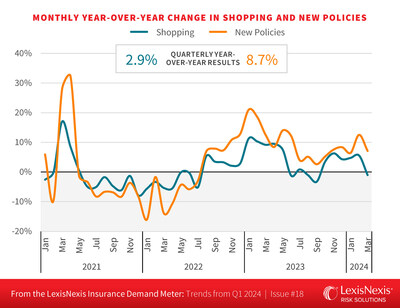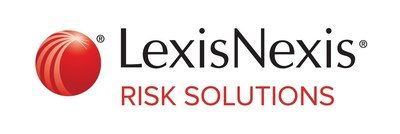U.S. Consumers Continue to Switch Auto Insurance at Higher Rates, Leading Carriers to Continue Focus on Renewal and Retention
The LexisNexis Insurance Demand Meter indicates U.S. auto insurance shopping activity rose by 2.9% year-over-year in Q1 2024, down from 4.7% in the previous quarter.
New policy growth was strong, showing an 8.7% year-over-year increase. Consumers continue to switch insurers, with 42% of insured households shopping in the past year.
Consumers loyal for over 10 years now make up 24% of shoppers. Older shoppers and tax refunds contributed to higher shopping rates during Q1 2024. Insurers are recommended to enhance retention strategies to maintain profitability, especially with a potential slowdown in Q2 2024.
Fewer large rate increases may change traditional shopping behaviors, and insurers focusing on acquiring and retaining profitable business could gain market share.
- Quarterly year-over-year new policy growth was up 8.7% for Q1 2024, marking the seventh consecutive quarter of increases.
- 42% of insured households shopped for new policies in the past 12 months, indicating consumer engagement.
- Consumers loyal for over 10 years now make up 24% of the shopper pool, up from less than 20% in previous years.
- More drivers entering the market in Q1 2024 offset the number of leavers, reversing trends from 2022 and 2023.
- Older shoppers and tax refunds contributed to increased shopping activity.
- Shopping growth in Q1 2024 at 2.9% is slower compared to the 4.7% increase in Q4 2023.
- Despite healthy shopping patterns for Q1 overall, March showed a slight decline in growth rates.
- The market could see a slowdown in Q2 2024, similar to the previous year.
Insights
The report from LexisNexis Risk Solutions reveals some significant trends in the auto insurance market. A 2.9% increase in shopping activity and an 8.7% rise in new policies in Q1 2024 indicate a dynamic market where consumers are actively seeking better deals. This is a continuation of a seven-quarter upward trend. However, the slight deceleration compared to the previous quarter's growth suggests that insurers might have to reconsider their pricing strategies to retain customers.
For retail investors, the most critical takeaway is the overall consumer sentiment towards higher premiums. The fact that only 24% of long-term policyholders are still shopping shows a shift in loyalty trends. This could impact the revenue stability of insurers as they might need to offer more competitive rates to retain these long-term customers, potentially squeezing profit margins.
Moreover, the data about older shoppers (66 and over) who are shopping at higher rates due to fixed incomes underscores a demographically driven market shift. Insurers might need to adjust their product offerings to cater to this segment, balancing between competitive pricing and profitability.
Investors should also note the potential risks and opportunities. A continued increase in consumer switching rates could lead to market share volatility among top insurers. Those with strong customer retention strategies will likely benefit, whereas companies slow to adapt may experience a loss in market share.
The LexisNexis Insurance Demand Meter highlights the seasonal and demographic factors impacting the auto insurance market. With older shoppers driving activity, it suggests a strong influence of fixed incomes and higher premiums on shopping behavior. This demographic trend could inform insurers about the need to tailor products specifically for older consumers, who might be more price-sensitive and looking for cost-effective solutions.
For retail investors, this points to the potential for niche market growth, particularly in insurance products designed for seniors. Companies that can effectively target this demographic with tailored packages or discounts could see increased customer retention and acquisition rates.
Another point to consider is the role of tax season, which saw an influx of previously uninsured consumers re-entering the market. This seasonal factor might not sustain throughout the year but provides a temporary boost in new policy growth. Investors should be cautious about overestimating this growth as it could level off post-tax season.
Additionally, the insight that fewer significant rate increases are being implemented highlights a shift towards stabilization in pricing strategies. Insurers might be using a more calculated approach to avoid the backlash of high premiums, balancing between customer acquisition and profitability.
The data from LexisNexis reveals an important trend towards higher retention among longer-tenured customers, now at 24% of total shoppers. This is an interesting shift as it indicates that even traditionally loyal customers are shopping around, likely due to the higher premiums. For insurers, this means that retention strategies need to be enhanced, focusing on personalized services and loyalty benefits to maintain this segment.
For investors, understanding this shift is important as it signifies underlying dissatisfaction among long-term policyholders. Companies that can successfully navigate this trend by offering better customer service and competitive pricing will likely perform better in the long run. Conversely, companies that do not adapt may face higher churn rates and reduced profitability.
Moreover, the continuous growth in new policy uptake over the last 20 months suggests an expanding market. Insurers that can capture new entrants effectively and retain them will benefit. However, it's important to note the potential for a market slowdown as indicated by the slight dip in March shopping activity. Investors should keep an eye on Q2 performance as it could be a harbinger of future market trends.
This information contextualizes the importance of strategic planning in the insurance market, where innovation in product offerings and customer engagement can drive growth amidst a competitive landscape.
According to the LexisNexis Insurance Demand Meter, a "Sizzling" Q1 2024 for new policies showed consumers are still not resigned to higher rates as insurers continue to adjust strategies to retain customers for long-term growth
Key takeaways
U.S. consumer auto insurance shopping activity registered as "Hot" on the LexisNexis® Insurance Demand Meter, as quarterly year-over-year shopping grew2.9% for Q1 2024 (slowing slightly from last quarter's4.7% increase year-over-year).- The quarterly year-over-year growth for new policies was "Sizzling," up
8.7% for Q1 2024 (and up again from +7.0% last quarter). - Quarterly year-over-year new policy growth increased, trending up for the seventh consecutive quarter and 20th straight month, meaning consumers continue to switch carriers at an increasing rate when they shop.
- Even as March saw a slightly lower shopping growth rate from the previous year – which may be attributable to fewer workdays and more weekends than in 2023 –
42% of insured households shopped in the last 12 months. - When comparing all years back to 2021, the consumers most likely to be retained by their existing insurance company – or those who have been loyal for 10+ consecutive years – comprised less than
20% of the shopper pool. Through Q1 2024, this cohort has grown to24% of total shoppers. - More drivers entering the market: In Q1 2024, the growth in new drivers largely offset the number of leavers. This bucks the trends observed in 2022 and 2023 where a record number of consumers left the market in response to higher premiums.
Tax refunds, older shoppers and Leap Day fuel shopping activity
- In Q1 2024, older shoppers (66-year-old and over) looked for insurance at the highest clip, with higher premiums helping incentivize those on fixed incomes to shop.
- Tax season delivered a shopping boost as more uninsured consumers re-entered the market despite purchase rates remaining lower than historical averages for the uninsured population.
- Despite healthy shopping patterns for Q1 overall, March was the outlier with shopping growth falling slightly negative.
"As we have seen more shopping in recent months from consumers who have traditionally been longer-tenured and more loyal, insurers with an appetite for growth may still have an opportunity to capitalize as these consumers seek to lower their premiums," said Adam Pichon, senior vice president, global analytics, LexisNexis® Risk Solutions. "Insurers may also want to consider implementing stronger retention strategies as they seek to return to rate adequacy and profitability, including more proactive and selective monitoring of their renewal books to help identity and retain those loyal policyholders."
Looking ahead
Though shopping has remained high through the first three months of 2024, it has not outpaced shopping growth from Q4 2023. With that in mind, Q2 2024 could serve as a litmus test as to whether the market could see a slowdown in shopping like last year or if there will be a shift in traditional consumer shopping behavior.
"Fewer large rate increases are being implemented by many insurers, but will traditionally loyal consumers now continue to shop, having realized there may be opportunities to save in the future? If so, this could present yet another shift in the shopping paradigm insurers must consider," said Pichon. "Those insurers with a measured approach to acquiring the right new business and retaining their most profitable business stand poised to gain market share as the industry overall continues to climb back to profitability."
Download the latest Insurance Demand Meter.
LexisNexis Insurance Demand Meter
The LexisNexis® Insurance Demand Meter is a quarterly analysis of shopping volume and frequency, new business volume and related data points. LexisNexis Risk Solutions offers this unique market-wide perspective of consumer shopping and switching behavior based on its analysis of billions of consumer shopping transactions since 2009, representing nearly
About LexisNexis Risk Solutions
LexisNexis® Risk Solutions harnesses the power of data, sophisticated analytics platforms and technology solutions to provide insights that help businesses across multiple industries and governmental entities reduce risk and improve decisions to benefit people around the globe. Headquartered in metro Atlanta,
Media Contacts:
Chas Strong
LexisNexis Risk Solutions
Phone: +1.706.714.7083
Charles.Strong@lexisnexisrisk.com
Dean Carney
Brodeur Partners for LexisNexis Risk Solutions
Phone: +1.646.746.5607
Dcarney@brodeur.com
![]() View original content to download multimedia:https://www.prnewswire.com/news-releases/us-consumers-continue-to-switch-auto-insurance-at-higher-rates-leading-carriers-to-continue-focus-on-renewal-and-retention-302147847.html
View original content to download multimedia:https://www.prnewswire.com/news-releases/us-consumers-continue-to-switch-auto-insurance-at-higher-rates-leading-carriers-to-continue-focus-on-renewal-and-retention-302147847.html
SOURCE LexisNexis Risk Solutions









